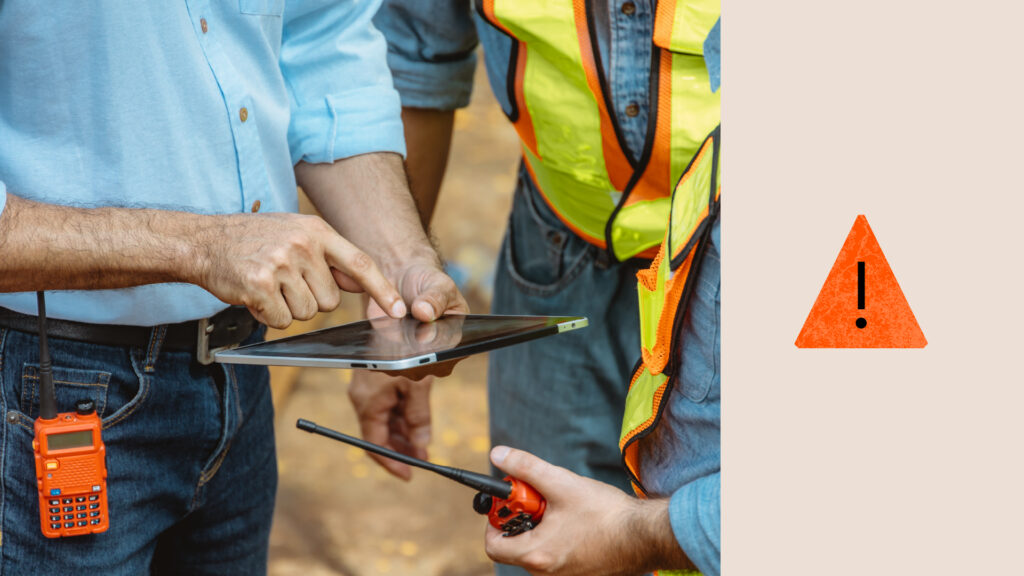— 4 min read
Data as a Risk Management Tool in Construction
Last Updated Aug 13, 2024
Last Updated Aug 13, 2024

High-caliber, competitive contractors have made strategic investments that help distinguish them as reliable and valuable partners. Technology is often chief among them. Of course, contractors who have made this investment are already aware of the obvious benefit of using software to keep projects on time and on budget. But many are just beginning to understand how their own data can create a flywheel that breeds a stronger safety culture and an improved risk profile in the eyes of insurers.
Because insurance is one of the top costs on a project, the most budget-minded contractors are using data strategies to reduce insurance costs and obtain broader coverage.
Table of contents
Data Drives Better Outcomes in Safety & Insurance
As nebulous as it may sound, beginning a journey to use data to strengthen safety programs and improve insurance outcomes is easier than one might think. That’s because the operational data a company is already capturing can enhance understanding of their performance in relation to risk mitigation. This can reveal areas of improvement, and translating these insights into action, they can power the flywheel of reducing risk. Not only will this result in favorable insurance rates and broader coverage, but it will also create safer, more profitable projects.
With the emergence of new data that wasn’t available in decades past, the three discussed the growing significance of data-driven risk management, and how it applies not only to traditional risk management but also to performance management, financial management, and even reputation management.
5 Key Ideas for Managing Risk Data in Construction
At HITT Contracting, we have changed the way we think about and approach our day-to-day practices, both on and off the jobsite, in a variety of ways that have brought tangible results.
1. Almost everything being collected is an indicator of risk.
When looking for data points to help assess and manage risk, start with anything captured via software that includes workflows or completion dates. Many successful risk managers look at observations, submittals, change orders, inspections, daily logs, and more.
For example, let’s look at requests for information (RFIs). RFIs happen on every single job. When analyzing RFI data, consider when they are happening and how quickly they are being responded to. If they are taking a long time, that means there is a higher likelihood of rework and schedule delays, which increases the chance for incidents to occur. In fact, some people refer to RFIs as Risk Frequency Indicators.
These data points allow firms to see where they missing the mark and where staff can make improvements.
2. The role of the risk manager is evolving.
Historically, a risk manager’s responsibilities included purchasing insurance and managing claims. However, the modern risk manager role has moved away from “handling insurance” to becoming a trusted advisor to the C-suite.
Risk managers are becoming an integral business partner because they have a deep understanding of revenue and exposure, and can advise on operations and strategy to bring value to the table. Access to technology and data is further accelerating this. Risk managers now have a historical view of where risk tends to creep in, and can use it to make better decisions and put practices in place so that risk management becomes proactive instead of reactive.
All that said, a good risk manager will operate in their role as if they are building guardrails — not stop signs — to keep everyone on the road where business is flowing while avoiding risk.
3. Managing risk is a shared responsibility.
Firms without a risk manager should tap into internal teams as well as external ones. By distributing risk awareness throughout the organization, everyone in the firm can become a safety champion.
To get started, lean on the external expertise of vendors, consultants, and partners who can help train teams to identify and manage risk. Then, as the business grows, it can add a risk manager.
4. Open dialogue between the broker and underwriter is adventageous.
The insurance landscape is evolving, with some adopting an entrepreneurial approach beyond using conventional underwriting models. To take advantage of this shift, foster transparent conversations with the broker and underwriter to establish trust.
Rather than proving someone owns a safety manual or mere box-checking, should shine a light on how internal safety practices have a tangible impact on the jobsite. Firms can contribute to the underwriting process and weave a favorable narrative by demonstrating that they have a history of efficient and effective operations, enabled by tech adoption.
5. The future of risk management is already taking shape.
The emergence of artificial intelligence, insure-tech, risk-tech, and construction-tech is collectively enhancing safety in the construction industry. For example, AI can help identify patterns and trends so that can proactively shift operations, prioritize preventative measures and mitigate risks before they occur. Monitoring devices can track equipment and workers. Water detection devices alert when an intrusion or leak occurs.
These tools allow users to respond and intervene immediately. Digital documentation and record-keeping can also help ensure compliance. Integrating these technologies significantly reduces the chance of human error, enhances safety protocols, and reduces accidents.
Was this article helpful?
Thank you for your submission.
100%
0%
You voted that this article was . Was this a mistake? If so, change your vote here.
Scroll less, learn more about construction.
Subscribe to The Blueprint, Procore’s construction newsletter, to get content from industry experts delivered straight to your inbox.
By clicking this button, you agree to our Privacy Notice and Terms of Service.
Categories:
Tags:
Written by
Chase Leist
Chase Leist is a CPCU based in the Washington DC-Baltimore area, and is currently the Vice President of Insurance & Risk Management for HITT Contracting. With over 20 years of insurance experience, Chase has become an expert at insurance and risk management in the construction industry.
View profileAnthony Dietz
Anthony Dietz is the Head of Insurance Brokerage at Procore. With over two decades of experience, Anthony has held several leadership roles in insurance, including Senior Vice President at NFP, an Aon company, and Vice President at Arch Insurance Group Inc. His expertise encompasses brokerage, soft skills, and teamwork, honed through his tenure at firms such as AIG, where he served as Regional Manager. Anthony holds an MBA in Management from Fordham Gabelli School of Business and a BBA in Finance from Hofstra University. Based in the New York City Metropolitan Area, he leverages his comprehensive knowledge and skills to deliver innovative insurance solutions in the construction sector.
View profileReviewed by
Kris Lengieza
Kris Lengieza is the Global Technology Evangelist at Procore Technologies. Kris brings a wealth of experience and passion to the intersection of construction and technology. Previously serving as the VP of Global Partnerships & Alliances, Kris oversaw a diverse ecosystem spanning channel, ISV, public, and association partnerships. His recognition as one of the Top 40 Construction Professionals Under 40 by ENR and BD&C underscores his impact in the industry. Kris’ journey began with 15 years working in the construction field, where he embraced technology as an early adopter and strived to seamlessly integrate data across all construction solutions. As a futurist and construction tech evangelist, Kris now collaborates extensively with industry innovators, tech organizations, and construction companies. Together, they explore transformative technologies that promise to revolutionize our work processes. Kris has played a pivotal role in Procore’s product strategy, delivering industry and technology insights to improve how Procore’s solutions serve the industry.
View profileExplore more helpful resources

Tackling the Top 10 Construction Industry Issues
The construction industry is constantly evolving, bringing both opportunities and challenges. Companies must navigate an array of construction industry issues — from workforce shortages to integrating new technologies into their...

Mission Critical Construction: Strategies for Success
Mission critical construction involves building structures whose functions cannot afford to fail, as any disruptions can lead to significant consequences for society. Keeping data centers, hospitals, power plants and other...

Modular Construction and MEP: A Collaborative Pairing
In an age of supply chain disruptions, workforce shortages, and rising material costs, off-site construction — including modular construction methods and prefabricated materials — is surfacing as a multipurpose solution....

Connected Construction: Transforming the Industry Through Integration
Construction projects are becoming increasingly complex, so companies need to innovate to accurately and profitably complete these modern structures. Connected construction — using technology and data to improve communication, processes...